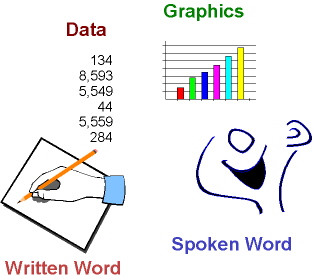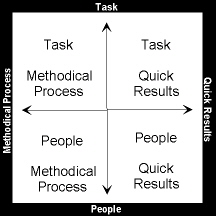|
|
Colorful Leadership
Harnessing the
Power
|
|||||||
|
||||||||
|
Communication: Media and Presentation Is the Message Getting Through? Are you making sense to your target audience? If you are not sure, think about this. Did you ever send out material in advance of a meeting, get to the meeting, and find out that most people did not read it? Don’t you hate that? What does this mean? Are the people too busy, too lazy, or maybe they just don't care? That is not it at all. If you talked in their language it would easier for them to come prepared to do meaningful work. Communications can come through multiple media, and because all of us are wired differently, most of us have a natural media. That is why when we communicate we do succeed with some people, but we miss others by a mile. It is a real challenge to reach everyone all the time. This is not a people problem or a motivation problem. The selected media could be getting in the way of effective communication. Media Written Words, Spoken Words Let’s contrast written words with spoken words. Words are words are words, however, some people want to see the words in writing, and others want to hear the words. When there is a organization change, some people will say, “I heard what they wanted, but I will wait to do something until I see it in writing.” Others will say, “sure there are a lot of memos, but please tell me what you really want me to do.” These simple statements are a hint into how that person processes information and what causes him or her to take action. We do not want to be amateur psychologists, but each person’s brain does process written and spoken words differently. Some people have a talent for processing written words. They read a book and they remember just about everything. They digest written reports and make sense out of them. Others have a great talent for processing spoken words. When they hear something it makes sense to them. If they attend a meeting and hear your message, they will remember it and can act on it. Most of us communicate in the style that is most comfortable to us. The problem is the other person may need a different mode. If I write a great report and the other person does not understand it, I need to try again. Perhaps, if I explain it verbally, it will make sense. We do not mean you should read the report to that person word-for-word. Plan your presentation like a great speaker would plan a speech. Written and spoken words are different because there are so many non-verbal clues that come through when you speak and they are lost when you write the words down. When you speak, people are paying as much attention to you as to your message. A different non-verbal set of information comes through with the written word. Things like spelling, grammar and neatness become critical for you to maintain credibility. Data and Graphics Now, let’s talk about data and graphics. For some people, numbers talk. They skip all the written words, and look for the numbers that make the ideas come alive. They like to see the facts and numbers lined up in neat rows and columns. Others cannot make sense out all this raw data. They need the graphs and charts to show trends and see meaning. A senior executive once told us that he received monthly reports with pages and pages of numbers . He noticed that his peers got a lot of valuable information from these reports, but he was confused. Furthermore, the people reporting to him were also confused. They knew they were losing money in their division but they could not see the trends and act on them. This executive had the numbers converted into graphs and suddenly, his team saw what was going on, and took action that lead to a profit the next year. It is interesting to note that his peers who got their information for rows and columns of numbers thought this executive was deficient because he did not act on the numbers. One of them even said, “We did not need all these charts; the numbers told the story.”
Let’s put this all together and see the four different styles. The numbers person goes to a baseball game, looks at the score board and likes to see the averages. One of our participants even told us, “I compute it as the game goes on.” The graphic person really likes the pictures on the scoreboard. The person who likes spoken words is listening to the game on a headphone radio, even though he or she is right there and can see all the action. Those who like written words enjoy reading about the game the next day in the newspaper. Sometimes we invalidate people who are different from us. Look at what you might hear about each media preference:
Here is the bottom line. Do you want action? If yes, are you willing to communicate in a medium that others can understand? If the answer is no, stop reading now. We can’t help you. We can’t fix the people who won’t read your report. We can’t fix the people who won’t listen to what you say. We can’t fix the people who don’t understand the numbers. We can’t fix the people who are waiting for a picture. If you want action, adapt your communications to other people’s needs. If you are communicating to more than one person, you probably need to use multiple media in order to make sense to more than one person. When in doubt, communicate in all four ways. It might just work! Presentation How to Present the Message There is more to the communication than the medium. There is the medium and the message. So far we have focused only on the medium. Let’s take a look at the message. What should you say and how should you approach it? Your goal is to make sense to the other person. Process-Oriented vs. Results-Oriented Some people want you to get to the point, quickly. If they ask a simple question they want a simple answer, not the whole story. Others want you to build the case first, and then they will be willing to look at a possible conclusion. They want the whole story, and they want it presented in a logical step-by-step progression. The first group we would call results oriented and the second group are process oriented. Communication can stop, even if you are still talking, when you are not saying what the other person needs to hear right now. For example, if you jump to the endpoint with process-oriented people, they will tune out the conclusion until they hear how you got there. By contrast, the results-oriented people tune out the details until they understand the point. After they get the point they will listen to the details. If you are giving details before getting to the point, you might as well be saying, “bla, bla, bla, bla….” Do you see how hard this is? You might be dong the exact wrong thing without even trying. What typically happens is we want people to understand us, we have good intentions, but we don’t stop for just a moment and ask ourselves how to approach the message. When it does not work, we just talk louder. We do more of what is not working. Task-Oriented vs. People-Oriented Some people want to start by identifying what we are going to talk about. Once they know that, all other information must be on track with the task at hand. Others like to know who is involved. They follow people’s feelings and needs, even if it takes them off task. They like to deal with the person before the thing. Let’s look at a phone call. Some people start with, “how are you doing?” They really mean it. They care about you and they appreciate a brief run down on how the day is going. Others want to know what the purpose of the call is so a statement like, “how are you doing," becomes meaningless. In fact it may even become irritating. After they deal with business, they might ask how you are doing, and mean it. With business done, they can relax and enjoy a short conversation. Can you see the potential for conflict and why there could be a breakdown in communication? This problem can be solved if we view it as a matter of sequence. With some people, deal with the person first, then the task. With others, deal with the task, then the person. Irritation is real when you work out of sequence. When task-oriented people hear things off-task, many become irritated because the other person is wasting time by getting off the point. When people-oriented individuals are forced to get right down to business they can become irritated because it is cold and downright rude. Let’s complicate the communication further. Task and Results What if you are task-oriented and results-oriented? What do you really want in communication? You want people to stay on task, go quickly to the point, and get it done. People and Results This group wants quick results because it makes all of us look good and we can all enjoy doing the work. When communicating with this person, be loose, have fun, and move quickly. People and Process These people want to hear the whole story, so slow down. Follow a natural process and don’t skip over points. Let the results take care of themselves over time. While all this is happening let them know that you care. Task and Process The first thing to recognize is these people are reserved. Don’t be surprised if they don’t react immediately to what you say. They want more information and time to think it through. Long pauses are ok. A short break would even be better. Give them time to respond.
When we teach our workshop, we are often asked, “How am I supposed to communicate at a meeting where there can be all kinds of people?” A good approach is start out by getting right to the point. You just pulled in the task/results group. Then give a quick story that engages the people and makes it meaningful. That pulls in the people/results group. Next, change the pace and slow down. Develop the case, step-by-step. Offer assurance that if the process is followed things will work out, and you will be there to offer support. This brings in the people/process group. The task/process group is hard to bring in. They need time do study and verify the information. When you plan the meeting, make sure you include breaks so people have the time they need to digest the information. By meeting the needs of each individual, you bring the whole team together. People like to be fair. When my needs are met, I am comfortable meeting other people’s needs. This is how you develop and nurture your team while you improve overall communications. People want to succeed and you are helping them do it. Copyright © 2003 Bill Kuehn and Steve Wille |

 All
Four Media
All
Four Media Putting
all four quadrants together
Putting
all four quadrants together